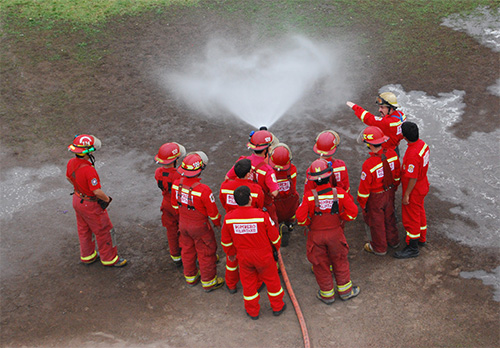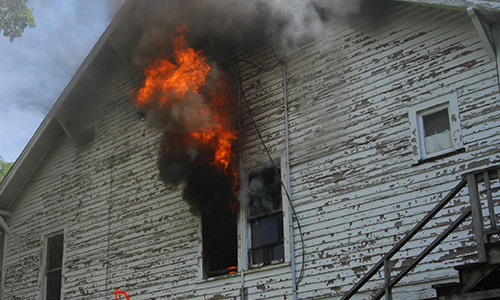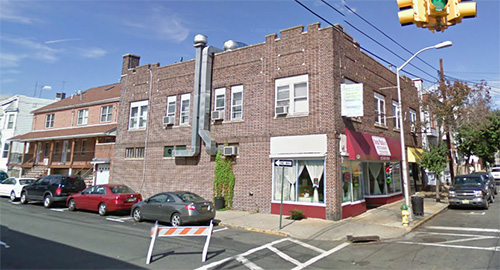More Fire Attack Questions
Sunday, March 31st, 2013
This post continues the discussion with Captain Mike Sullivan with the Mississauga Ontario Fire Department regarding fire attack methods. Captain Sullivan refined his definitions and explanation of direct, indirect, and combination fire attack, stating:
Direct Attack: Water droplets put out the fire (droplets land directly on the burning fuel and cool this fuel to put out the fire).
This is essentially correct, water applied directly to the burning fuel absorb energy as the water is heated and considerably more when vaporized into steam, this reduces the temperature of the fuel and extinguishes the fire. In the end, this is generally necessary regardless of what method of fire attack or fire control you begin with.
Indirect Attack: Steam puts out the fire (water droplets turn to steam and this expanded steam eventually makes its way to the area where the burning fuel is and continues to absorb heat from this burning fuel until the fire goes out. All this steam also reduces oxygen concentration which results in a reduced heat release rate).
This is close, but the process of steam production absorbs a tremendous amount of energy. So it might be more accurate to state that production of steam and that heating of the steam as the hot gases and steam reach a thermal equilibrium cool the fire environment. In addition, steam production reduces oxygen concentration that reduces heat release rate. These processes in combination control and in fewer cases may achieve extinguishment. Indirect attack almost always must be followed up with aggressive overhaul and direct attack to achieve extinguishment. This does not diminish the utility of indirect attack for control of fully developed fires or decay stage fires resulting from limited ventilation (where high temperatures exist).
Combination Attack: Water droplets put out the fire (the droplets act the same way here as in the direct attack).
As with direct attack this is essentially correct. The application of water to burning fuel results in extinguishment through cooling. With the combination attack, some of the water is vaporized in the upper layer, assisting with control of the fire environment as well as the process of extinguishment. However, this is often at the expense of disrupting thermal layering (less of an issue when well-coordinated tactical ventilation is provided in front of fire attack.
This discussion gave rise to several other questions from Captain Sullivan:
In the combination attack, although the hose stream is directed at the ceiling (indirect part of the combination attack) and creates steam it is not as effective at cooling the fuel as the direct part of the combination attack is (wow is that wordy), Therefore,the main purpose of the indirect part of the combination attack is to cool the overhead gases so the entire environment is cooler when firefighters enter and really doesn’t have much to do with extinguishing the fire. So would you say in this case the “indirect” part of the combination attack really isn’t a key contributor to extinguishment?
This would depend (another way of saying “it depends”). The indirect component of the combination attack is important in controlling flaming combustion in the upper layer (such as rollover). While control of the burning gases overhead alone will not achieve extinguishment (same as with gas cooling), it is an important component of the extinguishment process as the heat flux from burning gases overhead is significant both as a threat to firefighters and also as a mechanism for heating unignited fuel and continuing the combustion process of fuel that is already burning. However, in the end, it is the direct element of the combination attack that achieves extinguishment. As with indirect attack, combination attack is followed up with direct attack to achieve complete extinguishment.
If what I have said above is true then, although both the indirect and combination attack produce large amounts of steam, is the purpose of the steam production actually different (put out the fire vs. cool the overhead gases)?
The purpose of steam production in both cases is to take advantage of the high latent heat of vaporization of water to achieve cooling. In addition, indirect attack reinforces the cooling effects of steam production by reducing oxygen concentration and thus reducing heat release rate from the fire.
In his comments Stefan Svensson stated that “in order to put out the fire we need to hit it with water”, but from what we have discussed here, with an indirect attack it is not water putting out the fire but steam.
In the indirect attack, production of steam and related effects on oxygen concentration result in fire control, but not necessarily extinguishment. Consider the potential outcome if you used an indirect attack on a fire in a building an did not follow up with direct attack and thorough overhaul. Likely a return visit to the same building some time later for a rekindle. In the end, when dealing with Class A fuels typically found in buildings, it is necessary to put water on fuel that is burning.
When Nelson and Royer were doing their research on the Iowa Rate of Flow, did they use a combination attack or did they use and indirect attack and then develop the combination attack after their experiments?
The combination attack was developed during their experiments. Initial application of water was done using an indirect attack (similar to that described by Lloyd Layman in Attacking an Extinguishing Interior Fires (1955). The Iowa State Story: The Iowa Rate of Flow Formula and Other Contributions of Floyd W. (Bill) Nelson and Keith Royer to the Fire Service – 1951 to 1988 (Wiesman, J., 1998) provides an excellent overview of Nelson’s and Royer’s work (but their discussion of fire behavior is inconsistent with current theory and terminology). While out of print it is available (used) through Amazon and a number of other used book outlets.
There are many departments that will flow a straight steam ahead of them across the ceiling to cool the room as they make their way to the fire. I have read that this would be considered surface cooling and not gas cooling because a straight stream will pass right through the gas layer without cooling it and only cool the ceiling, upper wall and floor surfaces as the stream bounces off the ceiling and land on the floor. I have a few questions about this.
When straight stream from a combination nozzle or a stream from a solid bore nozzle deflects off the ceiling, does the stream get broken up enough that the droplets become reduced in size enough that they will cool the hot gas layer on the way down to the floor or are they still too large and therefore pass right through the hot gas layer without cooling it?
There is some cooling, but it is less efficient than when a fog pattern is used as the large droplets will be more difficult to vaporize. If temperature is extremely high, some cooling will occur as even large droplets may be vaporized. If the stream can reach the seat of the fire, this inefficiency may be less significant as the fire will likely be controlled by the direct element of the combination attack. When faced with hot gases or flaming combustion overhead with a fire that is shielded from direct attack, cooling the gases with pulsed water fog will be considerably more effective and efficient than use of a solid or straight stream.
When the stream cools the ceiling and upper walls are the ceiling and walls now able to absorb more heat from the upper gas layer ( so this actually would be gas cooling) and if so how effective is it at cooling these gases (how much heat can these cooled surfaces now absorb from the hot gas layer)?
As discussed in my last post, gypsum board (a typical compartment lining material) which has a specific heat of 1.017 kJ/kg (Manzello, Park, Mizukami, & Bentz, 2008). This is one quarter the specific heat of water and half the specific heat of steam. So the indirect cooling effect of removing energy from compartment linings is quite inefficient at cooling the fire environment.
Once you have created steam from applying water to the ceiling and upper walls—-does that steam not now effectively cool the gases? I know you need smaller droplets suspended in the gases to absorb heat from the upper gas layer and steam would certainly meet that criteria.
The specific heat of steam is 2.0 kJ/kg as compared to the combined theoretical cooling capacity of 2.6 MJ/kg when water is heated from 20o C to 100o C and vaporized into steam. While steam will cool the hot gases until they reach thermal equilibrium, but to a lesser extent than water fog applied into the hot upper layer.
Stefan Svensson mentioned in his comments that “sometimes fog nozzles are the best way to apply water to fire and sometimes it’s straight streams”. You often hear blanket statements being made about straight streams producing less steam and only fog streams can cool the gas layer. I was wondering if you could expand on the misconceptions and highlight some of the better practices we need to know about using the different streams from a more scientific point of view? When approaching a fire are we better to use both straight and fog patterns to cool the room as we make our way to find the base of the fire?
In a conversation with John Wiseman, Keith Royer stated that “there is not just one tool that will solve all fire problems”. The perspective that there is only one way to approach structural firefighting is dogmatic. Dogma is a point of view or tenet put forth as authoritative without adequate grounds. The simplest answer to your question is that when cooling gases, a fog pattern is more effective and when applying water to surfaces, the pattern selected may depend on the distance from the surface. When far away and the stream must be applied through a hot atmosphere, a solid or straight stream will likely be most effective, when close, a straight stream or fog pattern may be equally effective.
A question unrelated to this discussion but I am sure you can help me with. I am sure you are quite aware (or involved with) that excellent video called “kill the flashover” that shows the effects of closing a door. I know that the temperature stops increasing due to the lack of oxygen for heat release. But, not only does the temperature not increase but it actually quickly decreases. This decrease is due to the fact that the walls and ceiling are absorbing the heat causing it to drastically reduce so my question is this; if that fire was allowed to burn for long enough that the walls could no longer hold any more heat, then the door was closed, would the temperature drop have been less and would it have lowered more slowly?
The reason the temperature dropped so quickly was not due to the absorption of energy by compartment linings, but by reduction of heat release rate (HRR) due to consumption of oxygen within the compartment. So, it would not make a significant difference if the fire had been burning longer. The higher the HRR, the more quickly you would see an impact. This also influences the visible fire behavior indicators (smoke and air track) on the exterior. As demonstrated in the UL ventilation experiments and previous work by NIST, visible smoke and air track indicators decrease dramatically as the fire becomes ventilation controlled due to a reduction in temperature (and resulting reduction in pressure inside the building).
Thanks for the great questions, let’s keep the discussion going! The next set of questions comes from Garland TX regarding “Flashover Training”. A bit of controversy here in a number of areas!
References
Layman, L. (1955) Attacking and extinguishing interior fires. Boston: National Fire Protection Association (NFPA).
Wiesman, J. (1998).The Iowa state story: The Iowa rate of flow formula and other contributions of Floyd W. (Bill) Nelson and Keith Royer to the fire Service – 1951 to 1988. Stillwater, OK: Fire Protection Publications.




